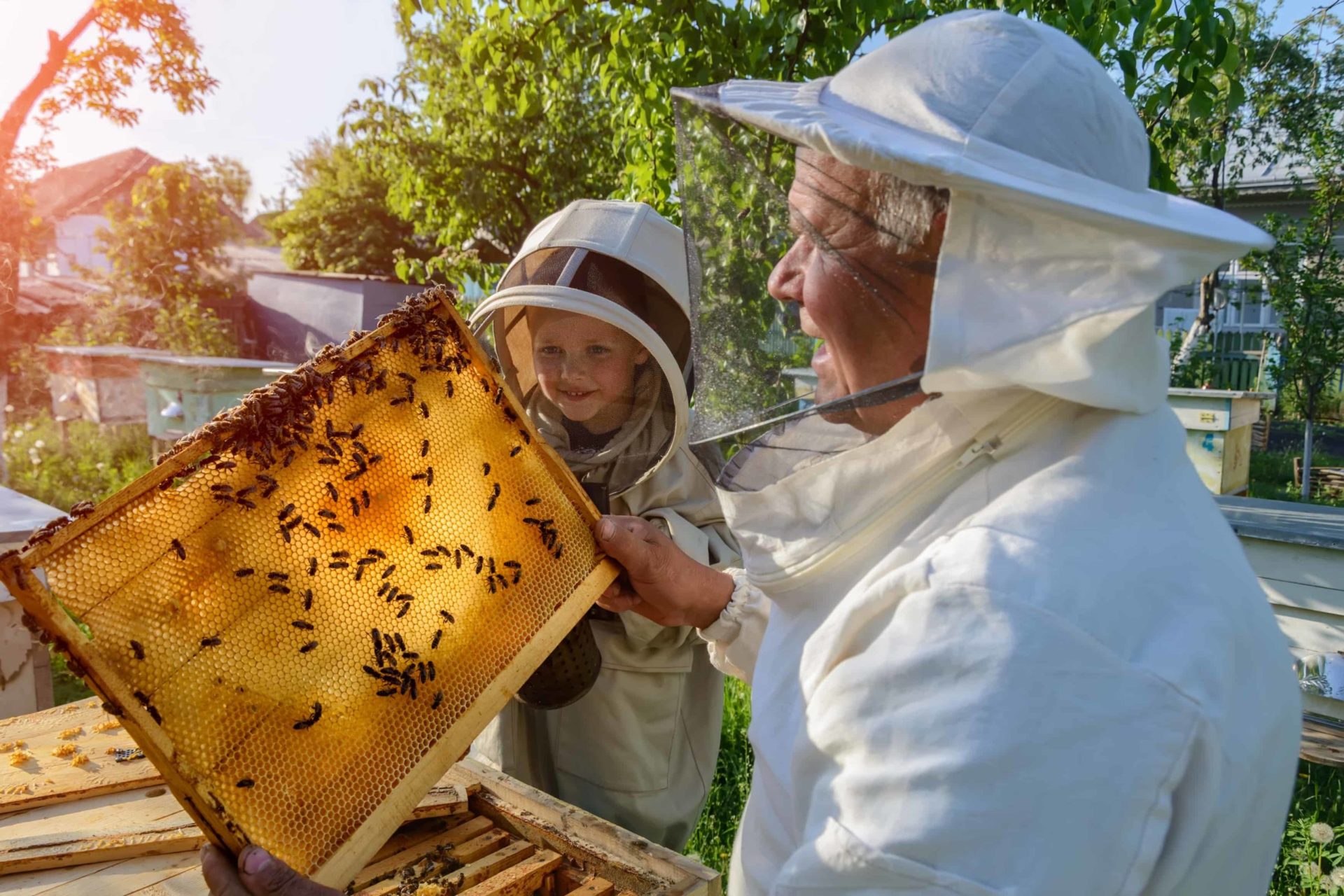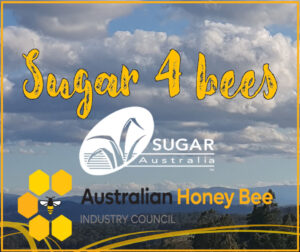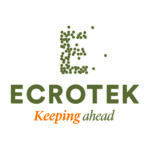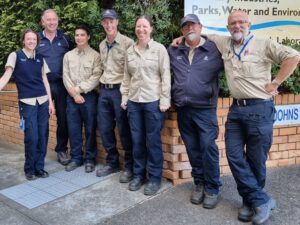Friends of AHBIC
If you aren’t already a Friend of AHBIC, we welcome you to join our group of organisations and individuals who are supporting Australia’s national beekeeping industry that supports you.


If you aren’t already a Friend of AHBIC, we welcome you to join our group of organisations and individuals who are supporting Australia’s national beekeeping industry that supports you.

The specially designed app will assist in maintaining hive record information that satisfies the requirements of the National Biosecurity Code of Practice. The program is intended for small commercial and recreational beekeepers who sell honeybee products direct to:
The low annual fee includes the use of the hive management app and an annual desk audit.
For further information go to www.btrace.com.au


AHBIC in partnership with Sugar Australia have launched the Sugar 4 bees program to assist beekeepers affected by the Emergency Response.
The first collection of Sugar 4 Bees took place in May, a second was completed in early August, we supplied sugar dust to several beekeepers with the help of the NSW DPI at Somersby.
Mid August with the generous assistance of Ecrotek in Blayney, additional dust was supplied to beekeepers in the Gumble Purple zone. There are still numerous bags available for Gumble Beekeepers, please complete the form below to secure your collection, we will be in touch to finalise with you.
additional dust was supplied to beekeepers in the Gumble Purple zone. There are still numerous bags available for Gumble Beekeepers, please complete the form below to secure your collection, we will be in touch to finalise with you.
Bianca Giggins is coordinating so if you are interested in registering for a collection, please complete the form below.
The sugar dust will be in 1 tonne bulka bags. If beekeepers cannot safely accept 1 tonne bags, arrangements will need to be made for smaller sized collection.
The dust is available to assist beekeepers maintain hive health whilst impacted by the current Varroa incursion. The sugar dust attracts moisture and will go solid if not used quickly.
CLICK HERE to secure a collection.

B-QUAL is an Industry Owned Quality Assurance System for Australian beekeepers.
How does B-QUAL certification benefit my business?
B-QUAL Certification also enables an enterprise to market its product under the B-QUAL logo to show that it meets the B-QUAL Industry Standards.
Complete your training at home at your own pace.
For more information and to obtain a Certification Information Pack, contact the B-QUAL Certification team.
www.bqual.com.au
B-QUAL Pty Ltd
Phone 07 49949820
Email: admin@bqual.com.au

Beekeeping is an exciting and rewarding hobby or business, that requires a significant amount of time and effort. As a beekeeper, it is essential to keep accurate records of your hive management activities as it provides valuable information about the health and productivity of your bees. Keeping records helps you track the progress of your hives and make informed decisions about how to manage them.
One important reason to keep records is to monitor the health of your bees. Keeping track of the number of bees, eggs, brood patterns, stages of brood, identifying and monitoring pest and diseases and honey production all help identify any issues with the hive’s health. By observing and tracking the health and growth of a colony, you can spot early signs of disease or pest infestations and take corrective action before the problem becomes too severe. The more hives you have, the more you’ll need to take these records, to refresh your memory and remind you what is on your ‘To Do’ list.
Records also help beekeepers manage the honey harvesting process more effectively. By observing and tracking the honey production within a hive, you can monitor how much honey each hive produces, identify any variations in honey yield, remembering what flowers when. This allows you to make informed decisions about how much honey to extract (will they have enough for winter?), and if there a shortage and an informed decision can be made around supplementary feeding requirements.
Keeping track of expenses is another critical aspect of beekeeping. Record keeping enables you to monitor the cost of maintaining each hive and how much you are spending on equipment, where it was sourced and feed. This information helps you plan your budget more effectively and manage your finances.
Keeping accurate records also play a vital role in the marketing of honey and other bee products. Consumers are increasingly interested in buying honey produced from healthy hives. Beekeepers who keep detailed records can demonstrate their honey is of high quality, prove their hives are American Foulbrood free, show their Certificate to confirm they are compliant with the Australian Honey Bee Biosecurity Code of Practice, these beekeepers are more likely to attract customers who value locally sourced, high quality, natural products.
Keeping records helps beekeepers learn from their experiences. By recording the success or failure of different hive management techniques, you can identify what works well and what doesn’t. This information can guide future management decisions, allowing beekeepers to continually improve their practices and enhance their honey production.
Finally, in Victoria keeping records is your obligation under the Livestock Disease Control Regulations 2017 Regulation 74P. Legal obligations around record keeping are designed to assist in the prevention, monitoring and control of honeybee pests and diseases by providing traceability. It is important to understand that you may be requested at any time to produce records of all hive movements, introduction of queens, swarms caught, and testing undertaken to assist the investigation of the source and spread of an exotic disease or pest outbreak, such as the current Varroa mite response in NSW.
There are several types of record-keeping options available, and the choice depends on the beekeeper’s preferences, needs, and resources. Here are some of the most common types of record-keeping options I see:
As you can see beekeepers have several options for record-keeping. Each option has its pros and cons, and the choice depends on the beekeeper’s needs, preferences, and resources. Regardless of the option chosen, effective record-keeping is crucial to manage hives, monitor their performance, and ensure the quality and safety of their products.
In the last few years Agriculture Victoria built and is maintaining a free digital diary (a record keeping system) for all registered beekeepers, called BeeMAX. Every beekeeper should already have their own BeeMAX account, that allowed them to register or renew their registration as a Victorian beekeeper.
Using this system has numerous benefits such as, improving record keeping accuracy, convenience, accessibility and ensuring compliance with the Regulations:
BeeMAX has also supported Agriculture Victoria with traceability and collation of mite check data allowing informed decision making to support the current NSW Varroa eradication efforts, and assisting us to have confidence that our state remains Varroa free
To those beekeepers using the BeeMAX system, thank you for supporting Agriculture Victoria work more efficiently and effectively in protecting the Apiculture industry in Victoria.
If you would like to learn more about using BeeMAX to keep your records, visit the Agriculture Victoria website: https://agriculture.vic.gov.au/livestock-and-animals/honey-bees/beekeeper-registration-and-hive-disposal
If you would like to learn more about what records you need to keep, visit the BeeAware website, Step 5 in the Biosecurity Code of Practice: https://beeaware.org.au/wp-content/uploads/2017/09/Australian-Honey-Bee-Industry-Biosecurity-Code-of-Practice.pdf
To make sure you’re up to date with Honey Bee notifiable pests and diseases in Victoria, visit the Agriculture Victoria website: https://agriculture.vic.gov.au/biosecurity/animal-diseases/honey-bee-pests-and-diseases/notifiable-bee-pests-and-diseases
Agriculture Victoria delivers the Victorian component of the National Bee Biosecurity Program (NBBP). The NBBP is coordinated by Plant Health Australia and funded by the Australian honey bee industry Levy with in-kind contributions from state and territory governments. Co-investment for Victoria’s delivery is also provided from the Honey Bee Compensation and Industry Development Fund and the Australian Government through the Farm Business Resilience Program.

February has been another busy month for AHBIC. The Varroa response continues to dominate our activities. Despite this we have been able to progress the establishment of the imported honey committee, progress on national agreement for an agreed alcohol wash protocol, establishment of the international honey bee product standards domestic mirror committee as well communicating with DAFF on biosecurity, imported honey testing protocols and developing export markets.
New Varroa detections continue to be found as the first round of surveillance nears completion in the Newcastle complex. These new detections are not unexpected and are mostly at low mite levels. However, the new detections do continue to expand the red zones capturing more beekeepers. This is devastating for all the beekeepers caught up in it, and we hear daily from destressed beekeepers in these zones.
The baiting programme has been continuing. Efficacy trials with managed colonies are showing quick mortality at a distance from the bait stations despite local honey flows reducing bait station visitations. All zones now have baiting activity with the program concentrating on working from the western side of the Newcastle complex back towards the east. Drone ballooning is being trialled in the Nana Glen area to estimate the feral bee density.
The new detections around the Taree area are disappointing and AHBIC has advocated on behalf of industry lobbying the DPI to fully investigate the circumstances surrounding these new detections. Whilst disappointing it is directly linked to the Newcastle complex and been detected relativity quickly limiting the possibility of significant spread through the area. The CCEPP will convene to discuss the new Taree area detections and determine the pathway forward for the response.
The Imported Honey Subcommittee has met for the first time to establish a strategy to combat cheap imports. As a result of the long discussions, it was resolved to establish a fund that will focus on ramping up imported honey testing by AHBC to generating data as a first step. This will provide information to demonstrate to the government the extent of the issue. The committee will meet again soon to continue working on strategies to address the problem.
AHBIC presented at the recent EvokeAg conference in Adelaide on biosecurity. The conference had over 1600 delegates across the 2 days. There was a strong honey bee flavour with many agritech startups targeting the honey bee industry. The conference provided an opportunity for AHBIC to meet with the Federal Minister for Agriculture and the SA Minister to further discuss and advocate industry issues while at the conference.
Feedback that AHBIC has provided to Plant Health Australia (PHA) in response debriefs has highlighted the need for more regular industry liaison training (ILO). As a result, PHA are running several training sessions across Australia with the first opportunity completed in Brisbane during February. ILO training will next be run in WA then Tasmania, SA before returning to the east coast. Keep an eye out at Plant Health Australia for this opportunity if you are interested.
The Executive are meeting to workshop the new AHBIC strategic plan and to develop the framework documentation before industry consultation of the final draft. We have many meetings around Varroa coming up including CCEPP and NMG discussions. Towards the end of the March AHBIC will be participating in the AgriFutures Levied Industry Forum to discuss common issues across industries and work on solutions with an opportunity to provide feedback to AgriFutures. AHBIC will be attending the national biosecurity roundtable towards the end of March. Other meetings scheduled include the National Residue Survey consultation, Indonesia’s Halal certification requirements, Vietnam market development and many more.

Welcome to Bianca Giggins, our Varroa Coordinator. Bianca has been busy learning AHBIC processes and systems and is now heavily involved in the varroa response. You can thank Bianca for this update. Bianca is a welcome addition to the AHBIC team.
As you can see from the CEO update AHBIC has been very busy. Thanks to DAFF for the Varroa Coordinator grant, because of this our CEO has been able to attend to matters whilst continuing to be involved in the varroa incursion.
We have been reviewing AHBIC’s budget – income and expenditure. The average loss for AHBIC over the last three years has been approximately $27,000 which is clearly not sustainable. With that in mind AHBIC cannot afford to send three people (CEO, Chair and Varroa Coordinator) to all state conferences. While state associations give AHBIC representatives free registration to the conference, AHBIC is still liable for travel and accommodation costs. To be responsible with Friends of AHBIC monies, only one or two AHBIC personnel will be attending each state conference to give AHBIC updates other than the VAA conference where the AHBIC AGM is immediately after their conference.
AHBIC has not actioned some of the motions from last year’s AGM. I make no apologies for this. The varroa response has been our number one priority. Now we have a Varroa Coordinator we are able to progress some of those action items and attend to other pressing matters.
Stephen Targett
Chair
The Queensland Government, Department of Agriculture and Fisheries (DAF), Hermitage Research Facility (HRF) Schools Plant Science Competition (SPSC) began in 1997 to help celebrate 100 years of agricultural research at the Hermitage Research Facility. It offers engaging ways for students to gain understanding and skills in key areas identified within the Australian science curriculum.
The aim is to stimulate an interest in science and agriculture in young people and to promote science and agriculture as a rewarding and exciting career choice. Encouraging the next generation of people who will be involved in agricultural/science careers is crucial to how we will face the future and is a key purpose of the competition.
In 2023 the Hermitage Research Facility is putting the microscope on bees to help students realise the impact of the recent Varroa Mite outbreak in NSW on the apiary industry and to discover the crucial role bees play in the viability of agricultural and horticultural industries and in supporting our very survival on this planet!
For Competition details :
Department of Agriculture and Fisheries, Queensland (daf.qld.gov.au)
Author: Jessica Bikaun (née Moran), Project Officer (Bees), Department of Primary Industries and Regional Development, Western Australia
Recently I had the pleasure of speaking at the Western Australian Apiarists’ Society about the bacterial brood disease American foulbrood (AFB). For the past four years, my PhD and life has revolved around AFB. I’ve dealt with it in hives, worked with it in the lab, conducted field tests, developed new methods for detecting it, smelled it, and, on one unfortunate occasion, even tasted it. I don’t recommend tasting AFB, but I do recommend that all beekeepers get familiar with the symptoms of the disease and have a clear picture of what steps to take if an outbreak occurs.
The Australian Honey Bee Industry Biosecurity Code of Practice (‘the Code’) has a number of requirements related to AFB – and for good reason. AFB is the most devastating bee disease in Australia and costs the industry millions of dollars each year. The disease is fatal to honey bee colonies, easily transmitted and can be incredibly persistent in apiaries – AFB spores can survive for over 50 years!
Historically, there has been a stigma about AFB, so beekeepers have been hesitant to talk about the disease or admit to having an outbreak. But let’s put that to rest, once and for all – anyone’s hives can get AFB. AFB does not discriminate; it can infect colonies that are weak or strong and affects both recreational and commercial beekeeping operations.
Industry reports and surveys have indicated that AFB has been on the rise for the past few decades – both here in Australia and overseas. In a New South Wales survey, almost 60% of beekeepers had a history of AFB in their apiary (NSWDPI, 2006) so chances are high that you will come across AFB at some stage. With this in mind, let’s break down the Code’s requirements for managing an AFB outbreak into three steps.
Under the Code, beekeepers must notify their local apiary inspector within 48 hours of detecting AFB. Report an AFB outbreak in your state or territory by calling the Exotic Pest Hotline 1800 084 881.
Remember, we are here to help. If you suspect your hive may have AFB but don’t know how to proceed, get in touch with one of your Bee Biosecurity Officers. We can make a diagnosis and help you put together a management plan. Reporting incidences of AFB is important, as it helps monitor AFB levels and allocate biosecurity resources as needed.
Unfortunately, there is no cure for AFB. (See below for why antibiotics are not a cure). The AFB-diseased colony is lost but you will need to act quickly to protect nearby hives. Under the Code, outbreaks of AFB must be dealt with immediately to prevent the disease from spreading. In practise, this involves isolating the diseased hive and, after the field bees have returned, euthanising the bees, burning the hive in a pit and covering the remains in at least 30 centimetres of soil. Any contaminated equipment and hive parts must also be destroyed or sterilised.
Dealing with an AFB outbreak can feel like a nightmare and euthansing a colony is a horrible task but it’s important to dispose of contaminated material correctly. Leaving diseased hives in a pile behind the shed or dumping them at the rubbish tip poses a significant risk to nearby beekeepers and is a serious offence. Even if the outbreak has destroyed your entire apiary, you still have a responsibility to eradicate the spores and protect the rest of the industry.
If you can’t destroy or sterilise contaminated materials straightaway, it is crucial to make sure it is ‘bee-proof’ – that is, bagged or sealed in such a way that bees cannot access honey or other hive products. If given the chance, bees will rob from exposed equipment, unwittingly taking spores of AFB back to their colony. Just make sure that out of (bee) sight doesn’t mean out of (your) mind! Spores of AFB can lay dormant for decades before causing an infection so if you forget to dispose of contaminated frame and boxes, your outbreak could come back to haunt you or whoever inherits your beekeeping equipment. This has actually been common in the United States, where large outbreaks of AFB caused many to give up beekeeping between the 1930s-80s and stored equipment came back to cause problems for unsuspecting grandchildren. So if you’re storing equipment, don’t forget about it – or at the very least, label it clearly!
Controlling AFB with antibiotics is prohibited on the mainland under legalisation, as it can create more problems than it solves. Antibiotics do not kill the spores of AFB, unlike European foulbrood, and will only mask the symptoms of the disease. In some parts of North America, beekeepers have been allowed to routinely feed their bees antibiotics to suppress AFB. However, as soon as the antibiotics stop, the spores being new infections. Masking the symptoms, rather than removing the diseased colonies, can lead to high levels of spores throughout the entire system. For example, in a 2005 study by the United States Department of Agriculture, 70-80% of the 95 beekeeping operations pollinating almonds in California tested positive for AFB spores. Scary stuff! On another note, antibiotics are a health issue, as they can contaminate the honey and lead to antibiotic-resistant bacteria. Although replacing destroyed colonies is expensive, it would cost us far more to lose the Australian bee industry’s clean and green reputation.
If you encounter AFB, tell other beekeepers – particularly those with apiaries nearby so they can check their hives for signs of the disease. Use the outbreak as talking point to help spread awareness about the disease and how to manage it. Conversely, if your bee buddy tells you about their AFB experience, remember to react with compassion. If you notice their beekeeping practices could be improved, let them know gently and avoid shaming. Remember – you are not a bad beekeeper if you get AFB. You are only a bad beekeeper if you get AFB and do nothing about it.
After an outbreak, take the time to think about how AFB entered your apiary and what steps you can take to prevent further outbreaks. AFB is commonly spread by beekeepers moving infected combs and hive components, or feeding contaminated honey or pollen. AFB can also spread naturally between colonies by worker bees robbing contaminated honey from diseased hives and – to a much lesser extent – bees drifting from diseased colonies into neighbouring colonies. With this in mind, consider the following when reviewing your beekeeping practices:
To put it simply, hungry bees spread disease. If nectar is scarce, bees will begin robbing honey from weaker colonies, which could be suffering from AFB. Avoid having hungry bees by leaving adequate stores of honey in the hive and, where necessary, feeding sugar. If you are adding protein to the hive, the best practice is to feed irradiated pollen or manufactured supplements. To minimise the risk of catching or spreading diseases, never feed honey or allow bees to rob from extraction equipment or exposed stickies.
A good barrier system is the most effective way to minimise the effects of an AFB outbreak. Barrier systems involve dividing the apiary into clearly identified, isolated sub-units. Hive components (e.g. frames, boxes) stay within their designated subunit and tools are cleaned when moving between units. For example, a single-hive barrier system means that materials aren’t moved between hives and frames are returned to the same hive after honey-extraction. If a colony catches AFB, a working barrier system would minimise the chances of the infection spreading to other hives – saving bees and beekeeping businesses.
Under the Code, beekeepers must inspect each colony at least twice a year. This is the bare minimum – inspecting colonies regularly will allow you to discover symptoms earlier and minimise outbreaks. This only works if you know what you’re looking for, so make sure you are familiar with the signs and symptoms of honey bee pests and diseases. Check out beeaware.org.au/training to complete the free Biosecurity for Beekeepers course and learn more about bee pests and diseases.
Diseased colonies may abandon a hive (abscond) in an attempt to escape the infection, however, worker bees can still carry the spores and cause infections in future brood. In a 2006 WA survey, 3.3% of feral colonies and swarms tested positive for AFB – statistically, that’s one in 30 swarms that are likely to be carrying spores of AFB. When collecting feral colonies or swarms, avoid introducing AFB to your apiary by keeping new colonies isolated and monitoring for disease.
For more biosecurity information and tips, visit BeeAware
![]()
The National Bee Biosecurity Program is funded by the honey bee industry through a component of the Agricultural Honey Levy, with state governments contributing in-kind resources. Plant Health Australia manage the program on behalf of the Australian Honey Bee Industry Council.

In late December 2022, Karla Williams moved on from her role as Senior Biosecurity Officer (Apiary Biosecurity) with the Department of Natural Resources and Environment Tasmania (NRE Tas). As the only apiary biosecurity officer in Tasmania, Karla was the Bee Biosecurity Officer under the National Bee Biosecurity Program, she coordinated the Tasmanian component of the National Bee Pest Surveillance Program and also undertook a majority of the field and office-based work in the state apiary biosecurity program. During her nine years in the apiary role, Karla effected some significant improvements in apiary biosecurity in Tasmania, over a time when beekeeper and hive numbers rapidly expanded. Karla established strong relationships with the apiary industry, which allowed her to work with many beekeepers to improve their biosecurity management practices in their hives. One of Karla’s desires before she left Tasmania was to see Compulsory Beekeeper Registration launched, which was achieved in December 2022, thanks to Karla’s tireless efforts in this area.

Replacing Karla Williams is Julie Lupia, who commenced in the role in January 2023. Julie has been working alongside Karla in recent months when she was employed by NRE Tas to manage a small team of apiary inspectors and co-ordinate a varroa mite surveillance plan in Tasmania developed in response to the incursion in NSW. Julie is passionate about bee biosecurity and is looking forward to her new and challenging role. If you have any questions about bee biosecurity in Tasmania, you can contact Julie at Julie.Lupia@nre.tas.gov.au

| National Council of Crop Pollination Associations | 16 May, – Penrith, NSW |
| New South Wales Apiarists Association | 18th-19th May – Penrith, NSW |
| Tasmanian Beekeepers Association | 26th-27th May – Hobart, TAS |
| Queensland Beekeepers Association | 15th-16th June – Toowoomba, QLD |
| South Australian Apiarists Association | 22nd-23rd June |
| Victorian Apiarists Association | 6th-7th July – Bendigo, VIC |
| Australian Honey Bee Industry Council – AGM | 8th July – Bendigo, VIC |
| Honey Packers and Marketers Association | TBA |
| Australian Queen Bee Breeders Association | TBA |
| Bee Industry Council of WA | Cancelled |